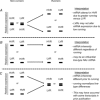Nucleus accumbens neuronal maturation differences in young rats bred for low versus high voluntary running behaviour
- PMID: 24665095
- PMCID: PMC4227898
- DOI: 10.1113/jphysiol.2013.268805
Nucleus accumbens neuronal maturation differences in young rats bred for low versus high voluntary running behaviour
Abstract
We compared the nucleus accumbens (NAc) transcriptomes of generation 8 (G8), 34-day-old rats selectively bred for low (LVR) versus high voluntary running (HVR) behaviours in rats that never ran (LVR(non-run) and HVR(non-run)), as well as in rats after 6 days of voluntary wheel running (LVR(run) and HVR(run)). In addition, the NAc transcriptome of wild-type Wistar rats was compared. The purpose of this transcriptomics approach was to generate testable hypotheses as to possible NAc features that may be contributing to running motivation differences between lines. Ingenuity Pathway Analysis and Gene Ontology analyses suggested that 'cell cycle'-related transcripts and the running-induced plasticity of dopamine-related transcripts were lower in LVR versus HVR rats. From these data, a hypothesis was generated that LVR rats might have less NAc neuron maturation than HVR rats. Follow-up immunohistochemistry in G9-10 LVR(non-run) rats suggested that the LVR line inherently possessed fewer mature medium spiny (Darpp-32-positive) neurons (P < 0.001) and fewer immature (Dcx-positive) neurons (P < 0.001) than their G9-10 HVR counterparts. However, voluntary running wheel access in our G9-10 LVRs uniquely increased their Darpp-32-positive and Dcx-positive neuron densities. In summary, NAc cellularity differences and/or the lack of running-induced plasticity in dopamine signalling-related transcripts may contribute to low voluntary running motivation in LVR rats.
© 2014 The Authors. The Journal of Physiology © 2014 The Physiological Society.
Figures








Comment in
-
Running for reward: a matter of the mature mind.J Physiol. 2014 May 15;592(10):2037. doi: 10.1113/jphysiol.2014.275230. J Physiol. 2014. PMID: 24833730 Free PMC article. No abstract available.
Similar articles
-
Dopamine D1 receptor modulation in nucleus accumbens lowers voluntary wheel running in rats bred to run high distances.Physiol Behav. 2012 Feb 1;105(3):661-8. doi: 10.1016/j.physbeh.2011.09.024. Epub 2011 Oct 6. Physiol Behav. 2012. PMID: 22001493
-
Mu-opioid receptor inhibition decreases voluntary wheel running in a dopamine-dependent manner in rats bred for high voluntary running.Neuroscience. 2016 Dec 17;339:525-537. doi: 10.1016/j.neuroscience.2016.10.020. Epub 2016 Oct 13. Neuroscience. 2016. PMID: 27743985
-
High and low nightly running behavior associates with nucleus accumbens N-Methyl-d-aspartate receptor (NMDAR) NR1 subunit expression and NMDAR functional differences.Neurosci Lett. 2018 Apr 3;671:50-55. doi: 10.1016/j.neulet.2018.02.011. Epub 2018 Feb 6. Neurosci Lett. 2018. PMID: 29425730
-
Phenotypic and molecular differences between rats selectively bred to voluntarily run high vs. low nightly distances.Am J Physiol Regul Integr Comp Physiol. 2013 Jun 1;304(11):R1024-35. doi: 10.1152/ajpregu.00581.2012. Epub 2013 Apr 3. Am J Physiol Regul Integr Comp Physiol. 2013. PMID: 23552494 Free PMC article.
-
Mu opioid receptor modulation in the nucleus accumbens lowers voluntary wheel running in rats bred for high running motivation.Neuropharmacology. 2015 Oct;97:171-81. doi: 10.1016/j.neuropharm.2015.05.022. Epub 2015 Jun 1. Neuropharmacology. 2015. PMID: 26044640
Cited by
-
Phosphorylation of CRY1 Serine 71 Alters Voluntary Activity but Not Circadian Rhythms In Vivo.J Biol Rhythms. 2019 Aug;34(4):401-409. doi: 10.1177/0748730419858525. Epub 2019 Jul 1. J Biol Rhythms. 2019. PMID: 31258021 Free PMC article.
-
Genetic architecture of motives for leisure-time physical activity: a twin study.Scand J Med Sci Sports. 2017 Nov;27(11):1431-1441. doi: 10.1111/sms.12779. Epub 2016 Oct 5. Scand J Med Sci Sports. 2017. PMID: 27704630 Free PMC article.
-
Cocaine-induced locomotor activity in rats selectively bred for low and high voluntary running behavior.Psychopharmacology (Berl). 2015 Feb;232(4):673-81. doi: 10.1007/s00213-014-3698-8. Epub 2014 Aug 9. Psychopharmacology (Berl). 2015. PMID: 25106389
-
Role of Inactivity in Chronic Diseases: Evolutionary Insight and Pathophysiological Mechanisms.Physiol Rev. 2017 Oct 1;97(4):1351-1402. doi: 10.1152/physrev.00019.2016. Physiol Rev. 2017. PMID: 28814614 Free PMC article. Review.
-
Five months of voluntary wheel running downregulates skeletal muscle LINE-1 gene expression in rats.Am J Physiol Cell Physiol. 2019 Dec 1;317(6):C1313-C1323. doi: 10.1152/ajpcell.00301.2019. Epub 2019 Oct 16. Am J Physiol Cell Physiol. 2019. PMID: 31618076 Free PMC article.
References
-
- Booth FW, Laye MJ. Roberts MD. Lifetime sedentary living accelerates some aspects of secondary aging. J Appl Physiol. 2011;111:1497–1504. - PubMed
-
- Brown JP, Couillard-Despres S, Cooper-Kuhn CM, Winkler J, Aigner L. Kuhn HG. Transient expression of doublecortin during adult neurogenesis. J Comp Neurol. 2003;467:1–10. - PubMed
Publication types
MeSH terms
Substances
Grants and funding
LinkOut - more resources
Full Text Sources
Other Literature Sources
Miscellaneous

